牛津译林英语9bunit1-welcome教案
- 格式:doc
- 大小:108.50 KB
- 文档页数:4
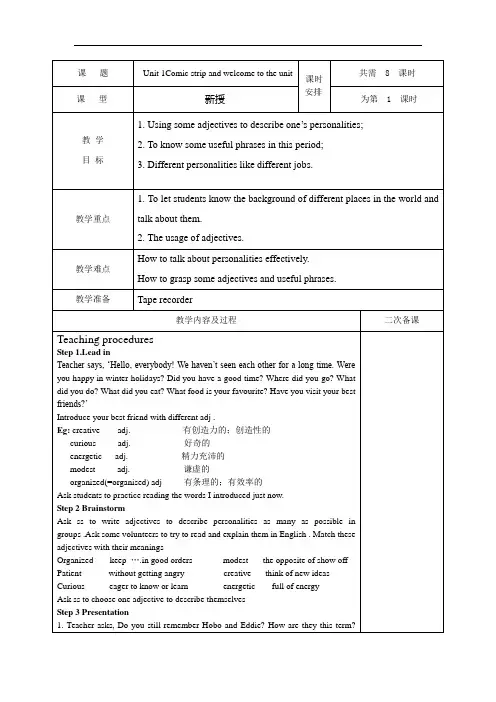

英语(九年级上册)Unit 1 Know yourselfComic strip & Welcome to the unitI. Teaching aims and learning objectivesBy the end of the lesson, students should be able to:1. use the right words to describe people’s personalities;2. talk about their own personalities and the job they like or dislike;3. learn to cooperate with others and respond to the teacher's instructions actively.II. Teaching contents1. New words and phrases: eat up, creative, curious, energetic, modest, organized, order, keep …in order, show off, grammar, come up with, neither, nor, accountant;2. New structure: Neither my parents nor I think I can make a good accountant.III. Focus of the lesson and predicted area of difficulty1. To talk about people's personalities;2. To talk about jobs and personalities.IV. Teaching proceduresA Comic stripStep 1 Lead inFree talk.T: Today we'll learn Unit 1 Know yourself. People often say what matters most is how you see yourself. Do you know yourself well? Are you a(n) friendly/confident/honest person?【设计意图:通过认识自己的问题导入新课,使学生迅速进入本课话题。


课题:Unit 1Welcome to the unit主备:赵青青课型:新授审核:区九年级英语备课组班级姓名学号_________________【教学目标】1.掌握下列重点词汇、词组和句型,并能熟练朗读和运用。
词汇:creative, curious, energetic, modest, organized, order, grammar, neither, nor, accountant词组:eat up, keep … in order, show off, come up with, be curious about, neither … nor …, make a good accountant句型:Mr. Wu is patient enough to repeat grammar rules for us.Neither my parents nor I think I can make a good accountant.It’s terrible for me to work without speaking all day long.2. 会用合适的形容词和适当的语言描述人的性格特点。
3. 会简单谈论自己和他人的性格特点及喜欢或不喜欢的职业。
【教学重难点】能用英语谈论自己和他人的性格特点及喜欢或不喜欢的职业。
【教学过程】Step1. Lead-inHave a free talk about the personalities of the studentsusing proper adjectives.Step2. Presentation&Practice1. Show the picturesin Part A on Page 7 and talk about them.2. Read the sentences in Part A and finish the exercises on PPT.Step3. PracticeⅠ (PartB)1.Have the students listen to the dialogue in Part B and finish the exercise on PPT.2.Have the students read the dialogue and explain some language points to them.3. Ask the students to make up a similar dialogue in pairs.Step4. PracticeⅡ(Comic strip)1. Have a discussion on the personalities of Eddie and Hobo.2.Watch the video on Page 6 and answer some questions.3. Read and fill in the blanks on PPT.4. Read and act out the dialogue in pairs.Step5. HomeworkFinish off the exercises.【课堂巩固】一、词汇运用。
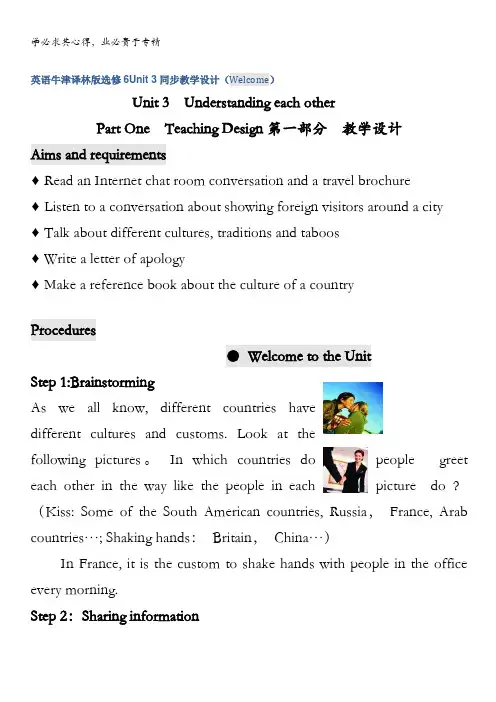
英语牛津译林版选修6Unit 3同步教学设计(Welcome)Unit 3 Understanding each otherPart One Teaching Design第一部分教学设计Aims and requirements♦ Read an Internet chat room conversation and a travel brochure♦ Listen to a conversation about showing foreign visitors around a city♦ Talk about different cultures, traditions and taboos♦ Write a letter of apology♦ Make a reference book about the culture of a countryProcedures●Welcome to the UnitStep 1:BrainstormingAs we all know, different countries havedifferent cultures and customs. Look at thefollowing pictures。
In which countries do people greet each other in the way like the people in each picture do?(Kiss: Some of the South American countries, Russia,France, Arab countries…; Shaking ha nds:Britain,China…)In France, it is the custom to shake hands with people in the office every morning.Step 2:Sharing informationLook at the following pictures and read the captions under them .Can you match the ways of greeting with the countries?Country/Area Ways of greetingHolland putting their hands together and bowing slightly Thailand kissing each other on one cheek and then the otherThe USA greeting each other by touching nosesSouth America hugging each otherThe Middle East shaking hands with each otherJapan bowing to each otherWhat about an Arab and a Japanese meeting for the first time?As a Chinese,if you are not familiar with greetings from other countries,what might happen?(Maybe we would feel embarrassed;we might be involved in awkward situations like…)Step 3: Discussion1.Do you know of any other ways of greeting that people around the world use?2.People in different countries greet each other in different ways。
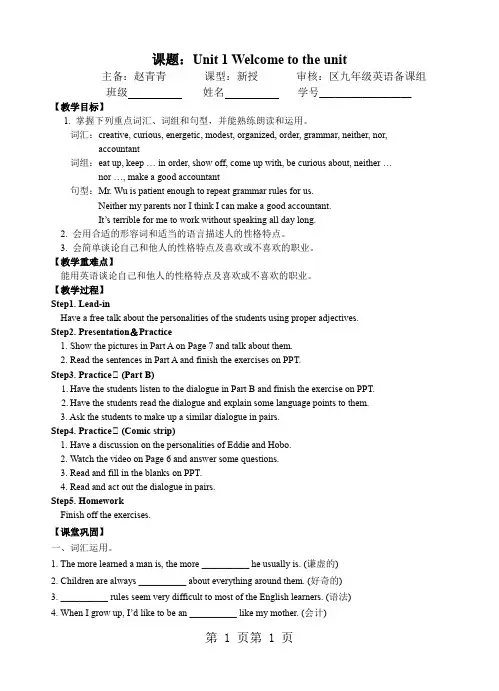
课题:Unit 1Welcome to the unit主备:赵青青课型:新授审核:区九年级英语备课组班级姓名学号_________________【教学目标】1.掌握下列重点词汇、词组和句型,并能熟练朗读和运用。
词汇:creative, curious, energetic, modest, organized, order, grammar, neither, nor, accountant词组:eat up, keep … in order, show off, come up with, be curious about, neither … nor …, make a good accountant句型:Mr. Wu is patient enough to repeat grammar rules for us.Neither my parents nor I think I can make a good accountant.It’s terrible for me to work without speaking all day long.2. 会用合适的形容词和适当的语言描述人的性格特点。
3. 会简单谈论自己和他人的性格特点及喜欢或不喜欢的职业。
【教学重难点】能用英语谈论自己和他人的性格特点及喜欢或不喜欢的职业。
【教学过程】Step1. Lead-inHave a free talk about the personalities of the studentsusing proper adjectives.Step2. Presentation&Practice1. Show the picturesin Part A on Page 7 and talk about them.2. Read the sentences in Part A and finish the exercises on PPT.Step3. PracticeⅠ (PartB)1.Have the students listen to the dialogue in Part B and finish the exercise on PPT.2.Have the students read the dialogue and explain some language points to them.3. Ask the students to make up a similar dialogue in pairs.Step4. PracticeⅡ(Comic strip)1. Have a discussion on the personalities of Eddie and Hobo.2.Watch the video on Page 6 and answer some questions.3. Read and fill in the blanks on PPT.4. Read and act out the dialogue in pairs.Step5. HomeworkFinish off the exercises.【课堂巩固】一、词汇运用。
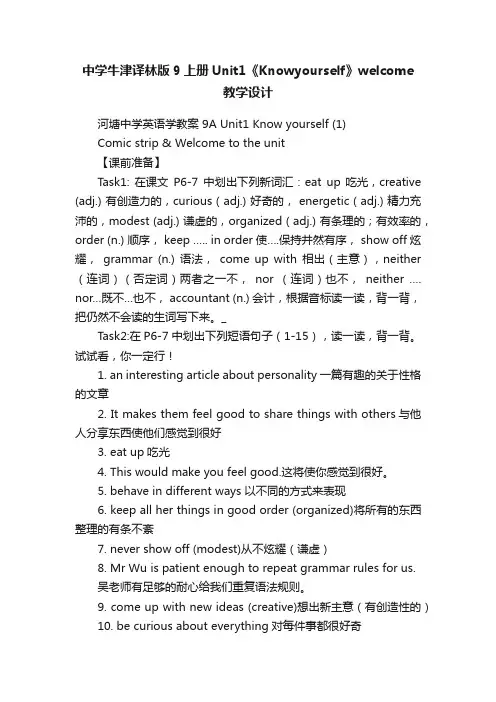
中学牛津译林版9上册Unit1《Knowyourself》welcome教学设计河塘中学英语学教案 9A Unit1 Know yourself (1)Comic strip & Welcome to the unit【课前准备】Task1: 在课文P6-7中划出下列新词汇:eat up 吃光,creative (adj.) 有创造力的,curious ( adj.) 好奇的, energetic ( adj.) 精力充沛的,modest (adj.) 谦虚的,organized ( adj.) 有条理的;有效率的,order (n.) 顺序,keep ….. in order 使….保持井然有序, show off 炫耀,grammar (n.) 语法,come up with 相出(主意),neither (连词)(否定词)两者之一不,nor (连词)也不,neither …. nor…既不…也不, accountant (n.) 会计,根据音标读一读,背一背,把仍然不会读的生词写下来。
_Task2:在P6-7中划出下列短语句子(1-15),读一读,背一背。
试试看,你一定行!1. an interesting article about personality一篇有趣的关于性格的文章2. It makes them feel good to share things with others与他人分享东西使他们感觉到很好3. eat up吃光4. This would make you feel good.这将使你感觉到很好。
5. behave in different ways 以不同的方式来表现6. keep all her things in good order (organized)将所有的东西整理的有条不紊7. never show off (modest)从不炫耀(谦虚)8. Mr Wu is patient enough to repeat grammar rules for us.吴老师有足够的耐心给我们重复语法规则。
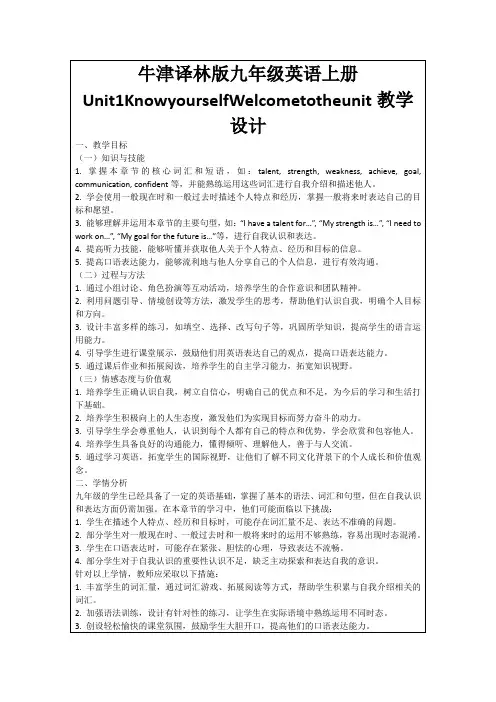

第二学期九年级英语教学设计9B Unit 1 Asia 课题Comic strip and Welcome to the unit总第课时备课时间上课时间课时Period 1教具 A recorder and teaching picturesMake the students learn more interesting places in China.TeachingTalk about different countries in Asia.aimsLearn some Chinese things.TeachingHelp the students learn to introduce some famous things in Beijing in English. focusDifficultTalk about different countries in Asia.pointsTeachingFree talk, Presentation, Practice, Consolidation.methodThe secondTeaching procedurespreparing lessonsStep1 Lead-inTalking about the places of interest in Beijing.1.Show some pictures to the students. Get them to guess what it is.2.Encourage the students to describe them.Step II Listen and readTell the students that Eddie and Hobo are visiting the Great Wall. a. Get the students to listen to the tape and find out what happened.1) What happened to Hobo?s feet?2) What was he doing then?3) What did Hobo advise Eddie to do?4) What was Eddie?s decision?. Get the students to read and practice the dialogue and then act the dialogue out.Step III PresentationGet to know the countries in Asia.1. Say“ what country is east to China.”Show some pictures about the country. (Japan)2. Say “ what country is northeast to China.”Ask:How does Mille learn about the world?why?How does Simon learn about the wwrld? Why?Work in pairs to practice the dialogue.Sample conversation :S1:How do you learn about the world?Show some pictures about the country. (Korea)3. Say “ what country is north to China. ”Show some pictures about the country. (Mongolia)4. Say “ what country is southwest to China. ”Show some pictures about the country. (India)Encourage the students to say something about these countries. Step IV Showing and discussionGet to know Chinese things.1.Show the pictures about Chinese things such as: dragon dance,Chinese opera, chopsticks, Chinese knot, Chinese paper cut and Chinese kung fu.2.Encourage the students to talk about the pictures.3.Encourage the students to say more about Chinese things.4.Get the students to talk about some famous Chinese things.Step V PracticeFinish the exercises in Part A.Talk about the places of interest in China.Step VIConsolidationWrite a short passage to describe one of the famous places in China and choose a piece of writing to read in class.Step5:HomeworkTeachingnotes9B Unit1 Asia课题Reading 1总第课时备课时间上课时间课时Period 2教具 A recorderTeaching 1. To guess general meanings from keywords and contextaims 2. To skim text for overall meanings and scan for detailsTeachingHelp the Ss to learn to introduce the places of interest in Beijing and GuilinfocusDifficultTalk about the places of interest in Beijing and GuilinpointsTeachingTask-based approachmethodTeaching procedures The secondpreparing lessons Step 1Free Talk1.Show a map of China, ask: Where would you like to go?2.Have a brief introduction of Beijing.3.Show some pictures about places of interest in Beijing and ask: Why do so manypeople dream of being to Beijing?Step 2Presentation1.Ask students to use different words to describe Beijing. [根源立网]2.Teach some new words3.Get students to go through the text and answer some questions1) Who once lived in the Forbidden City?2) Why do many tourists go to Tian ?anmen Square early in the morning every day?3) Where is the Summer Palace?4) What is Wei Ke ?s favorite attraction?5) Why was the Great Wall built in ancient times?6)Is Guilin in the north or south of China?7)Are there mountains and rivers in Guilin?8)How can you travel in Guilin?Step 3Further readingMatch the placesthe Palace Museum next to the Palace Museum Tian?anmen Square in the middle of Beijingthe Summer Palace in the north of Beijingthe Great Wall in the north-west of Beijing Read it again and do some true or false questions1) Beijing is in southern China.2) Tian?anmen Square is close to the Forbidden City.3) The Great Wall is built around theForbidden City.4) The Reed Flute Cave is in eastern Guilin5)You can find man-made lakes inside the Reed Flute Cave.6)We can take a boat trip along Li RiverRead the two parts carefully to get some details.1)Match the name with the correct information.2)Ask some questions and get the students to answer.3)Fill in blanks according to the passage.Step 4 ConsolidationDo some exercises on the exercise book.2. Post-teachingDemands(要求 ):1)Group one asks questions about Beijing and group two answers them.2)Group two asks questions about Guilin and group one answers them. . Rules:1)Time : only one minute.2)Ask and answer as quickly as possible .3)one question, one point; one answer, one point.4)The more, the better.Step5 Homework 1.Thinkoverhow to introduce acity 2.Have a tryintroduce our hometown to allTeachingnotes9B Unit 1 Asia课题Reading 2总第课时备课时间上课时间课时Period3教具 A recorder and teaching picturesTeaching aims Teaching To revise vocabulary and expressions to describe Beijin and Guilin, at the same time, learn more new words and phrases.1. To revise vocabulary and expressions to describe Beijin and Guilinfocus 2. To guess meaning from contextDifficultTo learn some useful expressions and use them in different contextpointsTeachingFree talk, Presentation, Practice, Consolidation.methodThe secondTeaching procedurespreparing lessonsStep1 RevisionAsk the following questions:1)Who once lives in the Forbidden City?2)Why do many tourists go to Tian?anmen Square early in the morning every day?3)Where is the Summer Palace?4)What is Wei Ke?s favouri te attraction?5)Why was the Great Wall built in ancient times?6)Which province is Guilin in?7)Is Guilin in the north or south of China?8)Are there mountains and rivers in Guilin?9)How can you travel in Guilin?Step 2 Presentation1.Reading the Text, try to find out the phrases below and get the class to translate the phrases below.get lost used to dobe attracted by in the pastbe filled with consist ofall over the area in ancient timesstep by step in different shapestake a boat trip fill people with surpriseat sunrise the raising of the national flag2.Reading the text , try to find the following sentences.1)The emperors in Ming and Qing Dynasties used to live here2)With wonderful buildings and art treasures inside, it is well worth a visit.3)Every day, many tourists gather there early in the morning, so that they can watch the raising of the national flag.4) It runs for over 6,000 kilometers across northern China,with watchovers every few hundred meters.5) It lies on the two sides of LiJiang River.6)In the north-west of beijing is The Summer Palace,a large achinese garden set in a natural landscape.Get the class to put the sentences into good Chinese.Step 3 PracticeDiscuss the following , and decide which passage are they belong to:1)located in the south of China2)emperors of the Ming and Qing dynasties lives here3)capital of China4)the Forbidden City has about 600 years? history5)surrounded by mountains in different shapes6)located in the north of China7)lie on the two sides of Li River8)tourists can hire a bicycle to ride around the city9)be praised as10)point upwards/hang down10) tourists come to see the Forbidden City, Tian?anmen Squ are and the Summer PalaceStep 4language explanationed to do/be used to doing/be used to do2.be well worth doing3.gather here and watch the raising of the national flag4.one of the wonders5.lie on two sides of6.stand in different shapes7.It ?s also popular to do sth.Step 5 RetellingGet the Ss to retell the text according to the notesof the two cities Kevin madeTeachingnotes9Bunit1 Asia课题Grammar总第课时备课时间上课时间课时Period 4教具Pictures tape Teaching Get the Ss to know the use of “it ”aimsUse it as a pronounTeachingUse it as an impersonal pronounfocusUse it to replace the real subject or objectDifficultLearn to use it correctlypointsTeachingTask-based approach Scene pedagogy and Teaching with humor methodThe second preparing Teaching procedureslessonsStep 1 RevisionReview the following sentences with“it”Look at the panda,it is so small.Another famous attraction is the Grate Wall,it runsLook at the cute baby, it is a boy ,isn ?t it?The little baby is drinking milk.It weighs only 3 kilos.--Who was calling you just now?--It was my cousin.Tourists like to take a boat trip along the Lijiang River.It is a great fun.Step 2 Working out the rulesWe use it for animals and lifeless thingsWe use it for a young child when we don ?t know whether it is a boy or a girlWe use it for an attractionWe use it for an unknown personStep 3 PracticeDo the exercise in Part AStep 4Learn the use of it as an impersonal pronounIt ?s 6:30p.m. It is raining heavily.In Beijing, it is cold.It is 2 kilometers from here to your school.It is 6:30 p.m. It is raining heavily outside.It is 1 January today. It is New Year’s Day.In Beijing, it is cold and windy in winter.It is two kilometres from my school to my____ was a sunny day. Peter decided to go for a walk to the park, though _____ was two miles away. ___ was so comfortable to walk on the street.Step 5 Do the exercise in partBStep 6 Learn the use of it ---to replace the real subject or objectIt is very tiring ti climb the steps.It is +adj.+(of/for)+to do sthIt takes some time to do sth.It is said/reported thatthinks/finds it easy /difficult to do sthIt is amazing that there are so many rocks in unusual shapes in the cave.It is important that we should learn English well.It is very tiring to climb the steps.It is popular to hire a bicycle and ride around the countrysideMany people find it pleasant to travel around.We think it important to learn a foreign language.该句型中的it 作形式宾语,为了记忆方便我们可称该句型为 "6123 构造 " 。

9B Unit 1 Asia9B Unit1 Asia9B Unit 1 Asia9Bunit1 Asia9BUnit 1 Asia9B Unit4 Asia9BUnit 1AsiaTeachingfocusTo review key grammar and vocabulary itemsDifficultpointsTo check their progress and tr y to ask questions they may have TeachingmethodT ask-based approach,Scene pedagogy and Teaching with humorTeaching procedures The second preparinglessonsStep 1 Warming-upTian’anmen Square go ontravel around Chinastart from herethe Palace Museumdragon danceChinese kung fuwonderful places to goa kind of traditional Chinese art a long way to gogo on travel around China start from here the Palace Museum dragon dance Chinese kung fu wonderful places to goa kind of traditional Chinese artStep2Language points1. The Great Wall is amazing, isn’t it?.They are students, aren’t they?He's to go home via Hongkong, isn't?Let's meet at the airport, shall we ?Have a little more wine, will you ?2The emperors of the Ming and Qing dynasties used to live here. (line10)used to do sth. : did something repeatedly in the past 过去常常(现在不了)eg. His careless driving led to the traffic accident.be/get used to doing sth. : 习惯做某事e.g. I am used to getting up early.be used to do. : 被用来做某事e.g. Brooms are used to sweep the floor.be(well)worth sth 非常值得…raise vt.举起,提起(某物)rise vi.(某物)上升,升起some…others…一些,一些;有的…有的…be praised as Art Palace of Nature询问某国、某地有多少人口时,不用"How much...?",而用"How large...?";在问具体人口时用"What...?"。

Unit 1Know yourself第一课时Comic strip & Welcome to the unit◇目标导航◇◇教学过程◇一、方法指导预习本课时的新单词,自主背默。
熟悉Page 6四幅图中的对话。
二、预习检测Ⅰ.汉译英1.有创造力的;创造性的creative2.好奇的curious3.精力充沛的energetic4.谦虚的modest5.有条理的;有效率的organized6.顺序order7.语法grammar8.(否定句中)两者之一不neither9.炫耀show off10.想出come up with Ⅱ.阅读Page 6中的对话,回答问题1.What does Hobo want to do?Hobo wants to eat Eddie’s breakfast.2.Is Eddie happy?Why?No.Because Hobo has eaten up his breakfast.Step1情景导入Teacher:Hello,everybody!We haven’t seen each other for a long time.Were you happy in summer holidays?Did you have a good time?Where did you go?What did you do?What did you eat?What food is your favourite?Step2完成教材Comic strip的任务1.让学生听录音,熟悉漫画的内容。
2.引导学生观察Page 6中的四幅漫画,回答下面的几个问题。
(1)What is the interesting dialogue about?It is about personality.(2)What makes generous people feel good?It makes them feel good to share things with others.(3)What happens to Eddie’s breakfast in the end?Hobo has eaten it up.3.让学生听录音,熟读漫画中对话的内容。
牛津译林版九年级下册英语Unit 1 Welcome教案班级姓名学号【教学目标】1. 掌握下列词汇、词组和句型并能熟练朗读和运用。
词汇:tiring, step, chopsticks词组:a long way to go, had better keep moving句型:Wow, the Great Wall is amazing, isn’t it?It’s tiring to climb the steps and my feet hurt.Wake me up on your way back.2. 探讨中国风格的事物,简单了解其情况。
3. 用英文简单介绍北京的一些风景名胜。
【教学重难点】能用英语介绍中国的一些风景名胜。
【教学手段】PPT【教学过程】Step1. Lead-inHave a free talk.Step2. Presentation1. Introduce and present some Chinese things.2. Have the students finish Part A.Step3. Listening and practiceⅠ1. Present some Chinese places.2. Have the students listen to the tape, and then answer two questions.3. Have the students read Part B in roles.4. Ask students to make up a new dialogue.Step4. Listening and practiceⅡ1. Have the students listen to the tape, and then answer some questions.2. Have the students read and act.Step5. HomeworkFinish off the exercises.【课堂巩固】一、词汇运用。
Wele-Unit 1 School LifeAims and requirements♦ Read a magazine article about school life in the UK and two other articles about school clubs♦ Listen to a headmaster talking about school activities♦ Discuss daily school life with your class partner♦ Report your school activities to your class teacher♦ Write a notice about school activities♦ Make a poster for a new school clubprocedures●Wele to the unitStep 1: BrainstormingIt’s the beginning of a new term. You have just finished junior high and ar e about to enter a new period in your studies. I am very happy to have all of you in my class and I hope we can be friends. I can see that some of you are eager to know what studying at senior high will be like. Will it be different from junior high? Well, there are certainly many differences between junior high and senior high, but there are also some things that are the same in every school in China. What about schools in other countries? Do students learn differently and have different experiences? Are schools all over the world the same?This is the subject of our first unit. Today we are going to look at schools in the United Kingdom and try to work out if they are the same or different from schools in China. Here are four pictures that show some aspects of school life in the UK. Please look at the pictures, read the instructions and try to determine the differences between schools in China and the UK.Step 2: Discussing and practicingLet’s have a discussion for several minutes.(The teacher can use the following contents to help students.)Now try to bine your own school experiences with knowledge gained from this text and other sources, so that you can participate fully in the discussion.(Give studentsa couple of minutes to talk about the following three questions.)1. Do you know any other differences between the lives of Chinese and British high school students?2. What kind of school activities do you enjoy?3. What is your dream school life like?Now in groups exchange your opinions and everyone is supposed to speak out your idea. Each group will then report your conclusions to the whole class.。